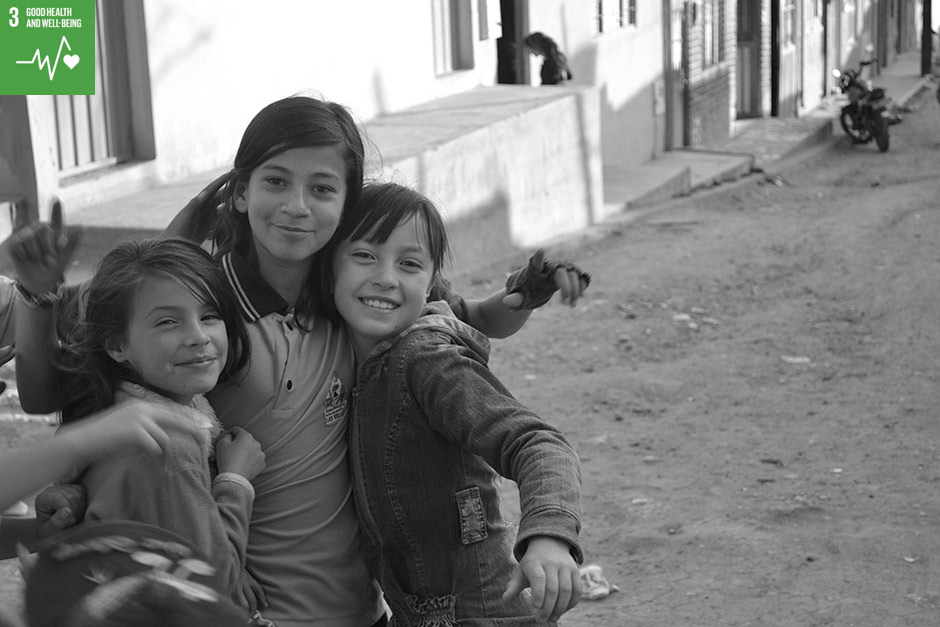
The last five decades of continuous internal conflict and violence have resulted in over six million people to be displaced or forced from their homes in Colombia, disproportionately impacting women and children. Many children are living in unsafe, violent communities and are at real risk of being forced into armed warfare, crime, sexual abuse and exploitation, human trafficking, and violence.
Colombia has the worst teenage pregnancy rates in Latin America with higher rates for displaced girls. In Soacha, 30% of displaced girls ages 13-19 have been pregnant at least once. The minimum age for marriage is 12 years for girls and 14 years for boys. Child marriages and early pregnancies have a serious detrimental effect on the health, education, and development of the girl child. These are violations of the UN Committee of the Rights of the Child and of Colombia’s girls and women.
GirlsRock! is an after-school technology and health education camp for displaced girls ages 12-20 years in Soacha, Colombia (located in the rural outskirts south of Bogotá, and home to many displaced people). Girls learn how to use technology to research, document, and disseminate information on issues related to sexual abuse, exploitation, reproductive rights, sexually-transmitted diseases, HIV/AIDS, teen sex trafficking, and adolescent pregnancy. It improves academic performance, competencies (communication, teamwork, time management, problem solving, and confidence), and positive learning attitudes through the use of e-learning and digital research tools. It promotes emotional well-being and intellectual growth of girls to take ownership and responsibility of their lives in a learning environment that fosters no bias in attitudes towards girls.
Young Girls Science & Health Tele-Academy Sub-Saharan Africa has the shortest longevity of life in the world at 59.2 years—many years less than the United States (79.7 years) and the European Union (80.2 years).[1] This is primarily due to infectious diseases (e.g., malaria and yellow fever), communicable diseases (e.g., HIV/AIDS), lack of sex education, availability of running water, and lack of access to health care, prenatal care, immunizations, community-based clinics, hospitals, and all-season surface road availability to get to medical care.
In Sub-Saharan Africa, health is a critical issue. Involving young girls in identifying and providing solutions for persistent health issues is key in improving health conditions and health infrastructure. Connecting girls with health educators and leaders, doctors, and medical professionals throughout the world by virtual means allows them to not only bring best practices to their community and families, but is a source of mentors to girls who may not have known anyone in medical or health fields, or had a source of role models, until then.
Relevant and critical health issues include:
- Infant Mortality Rate: Of every 100 infants born in Sub-Saharan Africa, six babies die (5.6)—this is .6 in the United States and .4 in the European Union.[2]
- Over 95% of Sub-Saharan Africa is at high or very high risk of major infectious diseases such as malaria, yellow fever, dengue fever, typhoid fever, hepatitis, etc.[3]
- HIV/AIDS in Sub-Saharan Africa leaves many children parentless at very young ages—although over 5% of adults in Sub-Saharan Africa live with HIV/AIDS, it ranges from .3% of the adult population in Madagascar to 28% in Swaziland.[4]
- The availability of physicians severely limits the access to or availability of quality health care. In Sub-Saharan Africa, there are only .2 physicians per 1,000 individuals, translating to 5,000 patients per physician. This compares to 295 patients per physician in the European Union and 408 in the United States.[5]
- Use of contraception is considered an indicator of health services, the country’s level of development, and women’s empowerment. Lower rates can indicate male-dominated societies or policies.[6] Although 76% of women of child-bearing ages in the United States use contraception, it’s only 27% in Sub-Saharan Africa. In Nigeria, only 15% use contraception.
Being able to use technology to collaborate with digital peers, leading educators, and health professionals to research, document, and disseminate information on a concrete health reality the girls themselves or their community members are faced with provides them with greater personal empowerment that positively impacts the decisions they themselves make.
YTF programs (GirlsRock! in Colombia and Young Girls Science & Health Tele-Academy in Africa) result in girls choosing careers in STEM (science, technology, engineering, and math) fields, including in health and medicine. Female representation is low at all levels of the STEM career pipeline, from interest and intent to majoring in a STEM field in college to having a career in a STEM field. Studies show that girls lose interest in math and science during middle school, and that STEM interest for girls is low compared to boys. Although three-quarters of girls are interested in STEM topics, much of the loss of interest is due to lack of exposure and in not knowing someone in a STEM career. When girls know a female in a STEM career, nearly 50% more girls become interested in STEM fields.[7]

